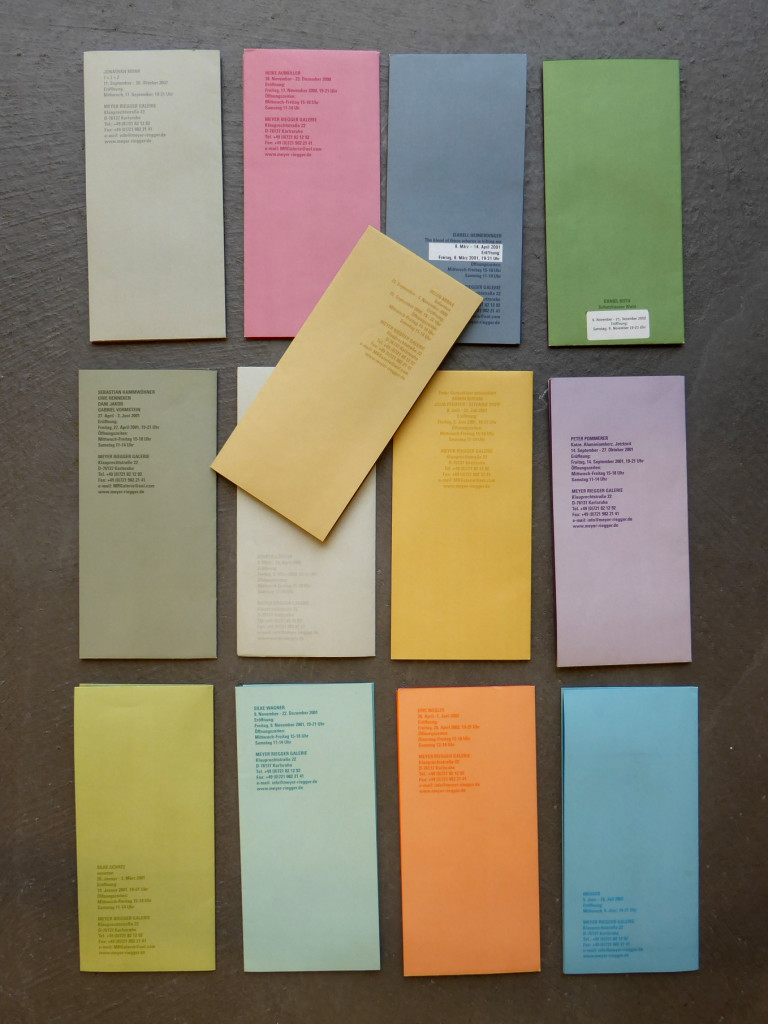
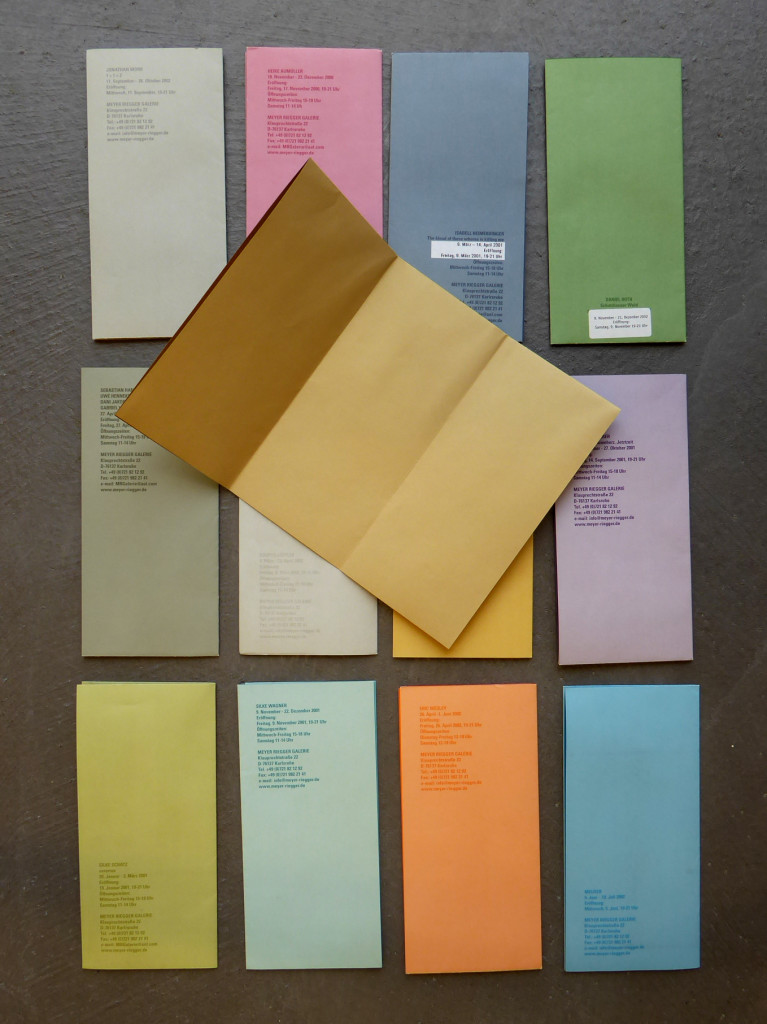
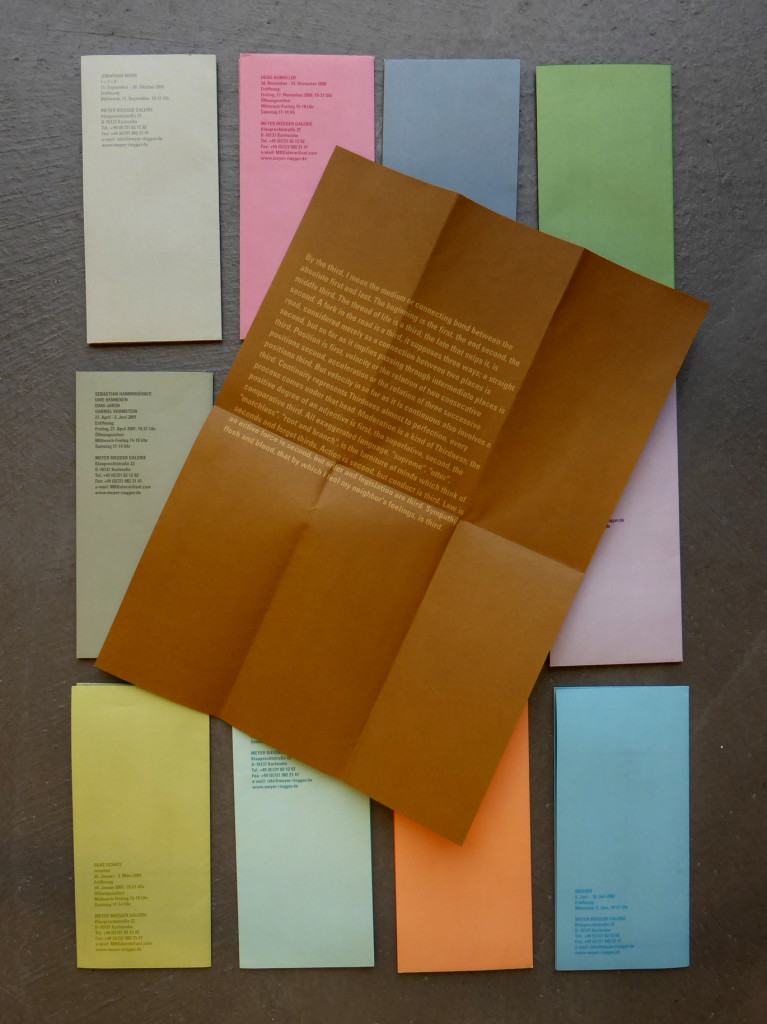
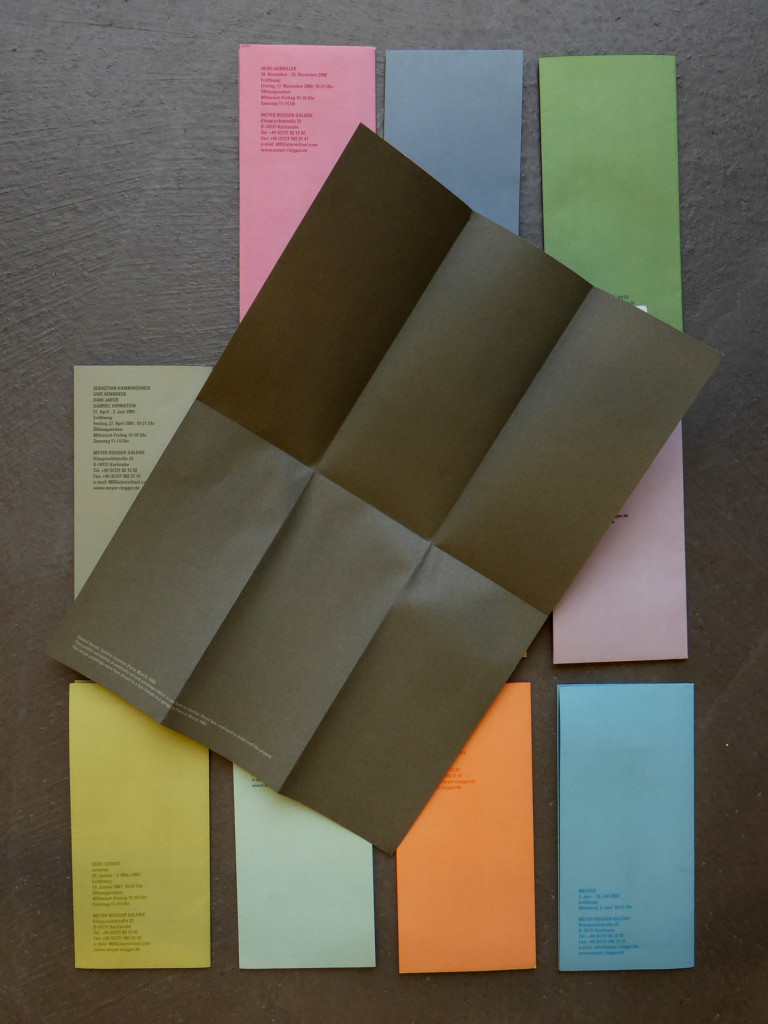
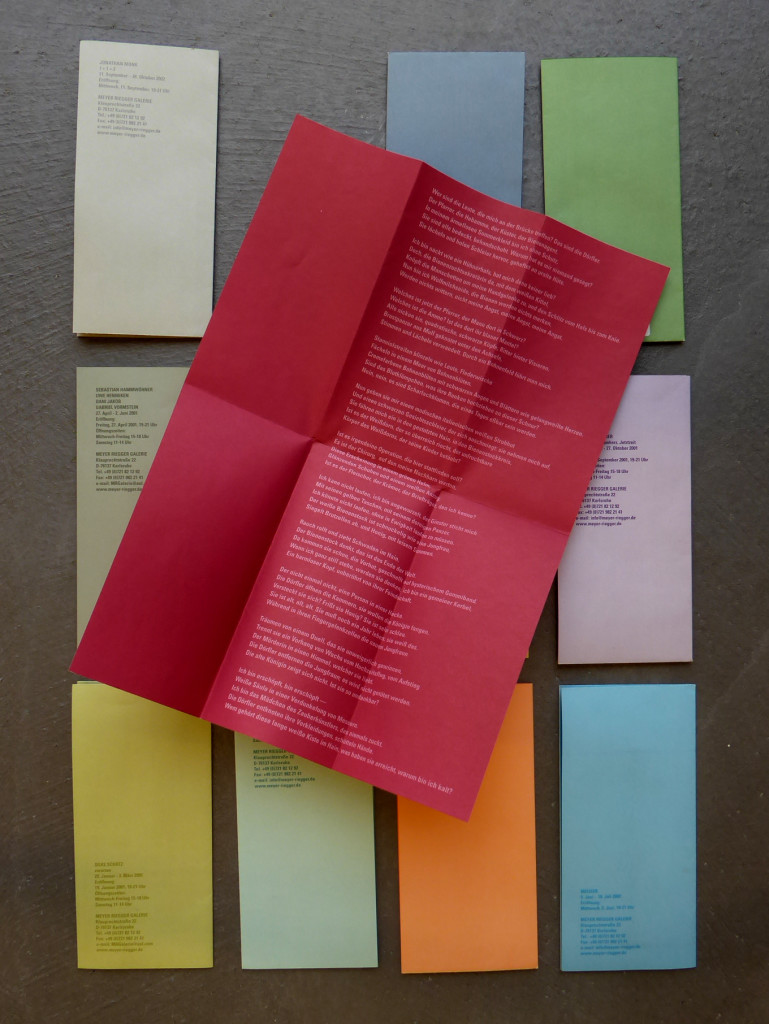
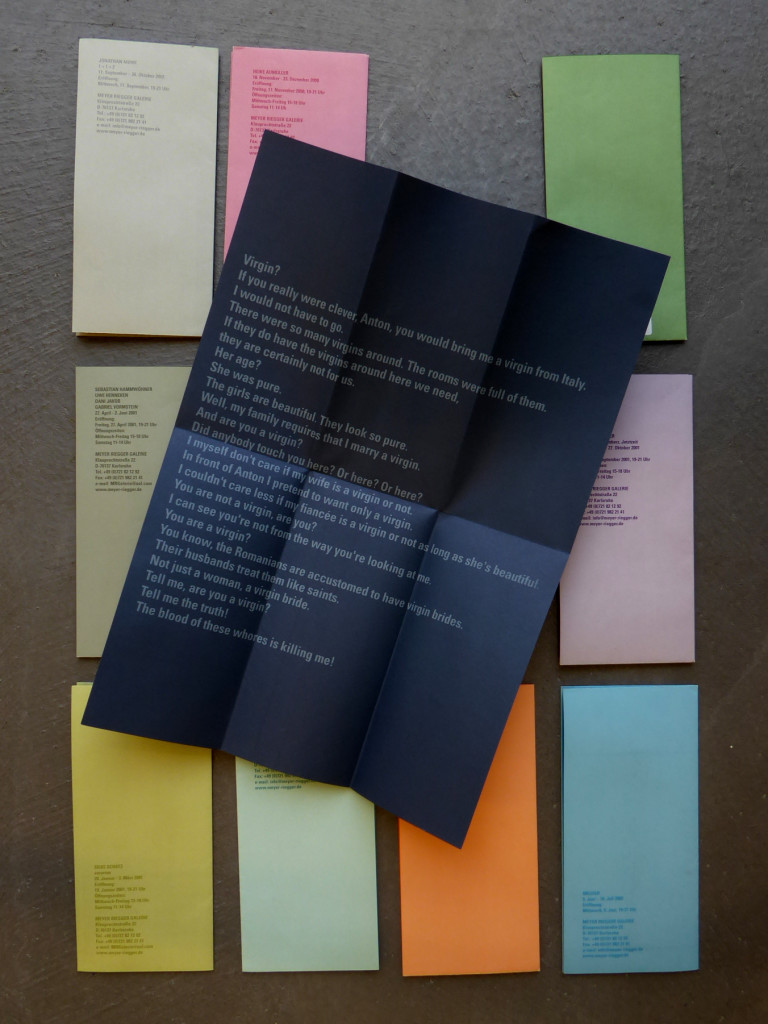
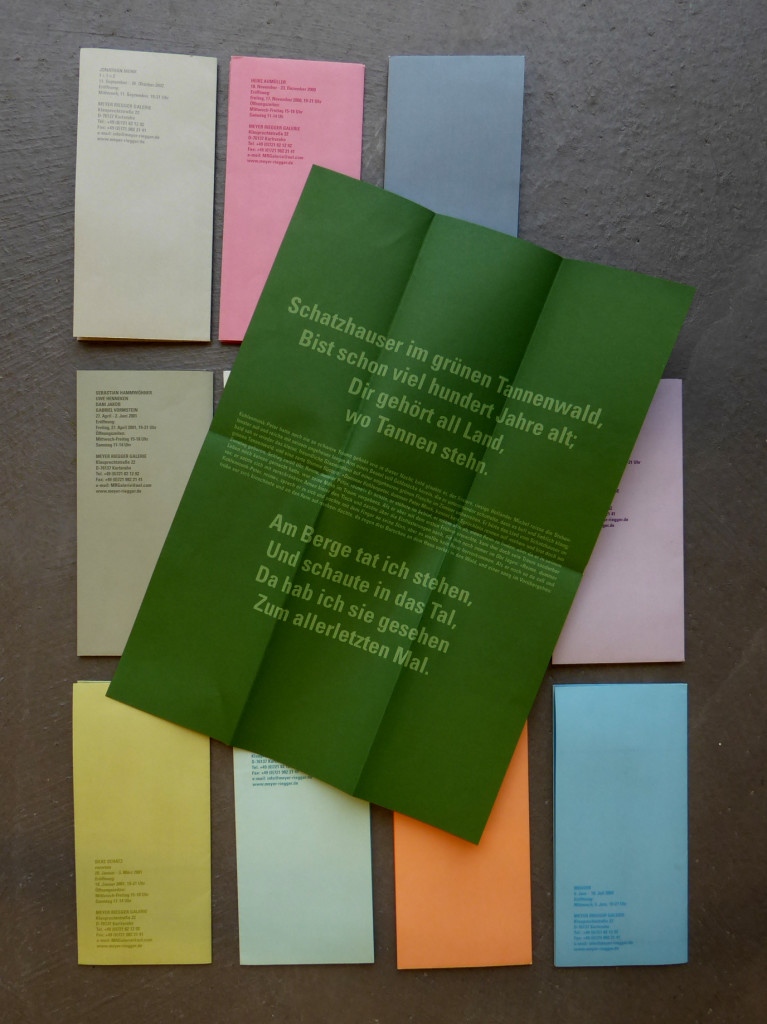
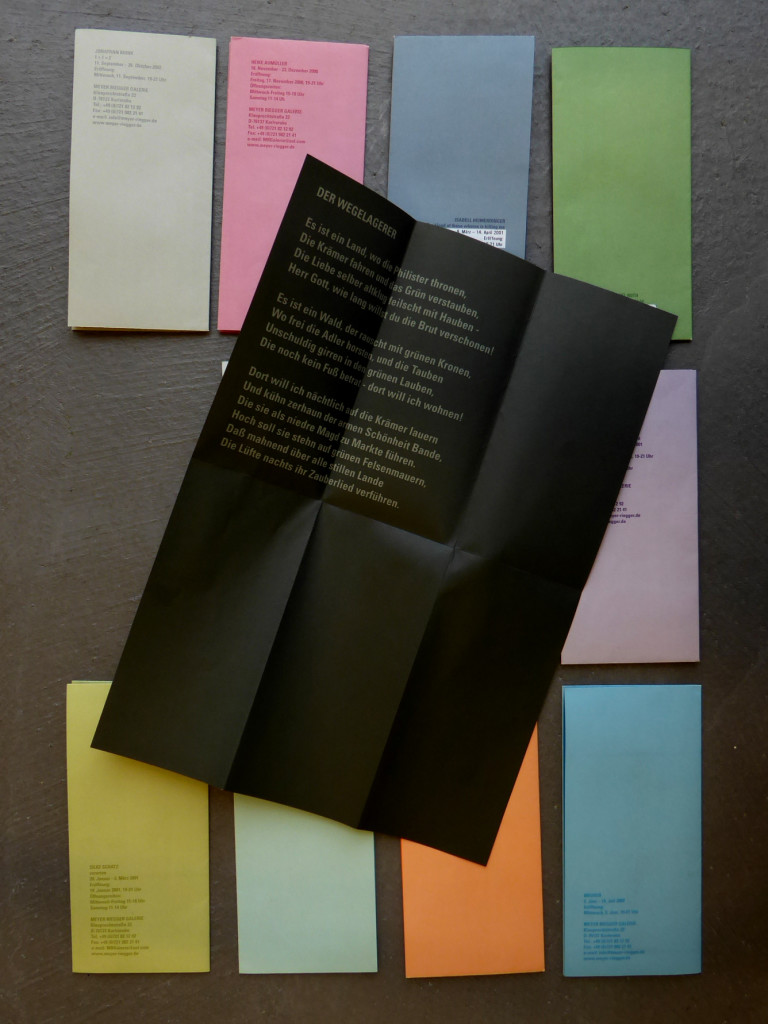
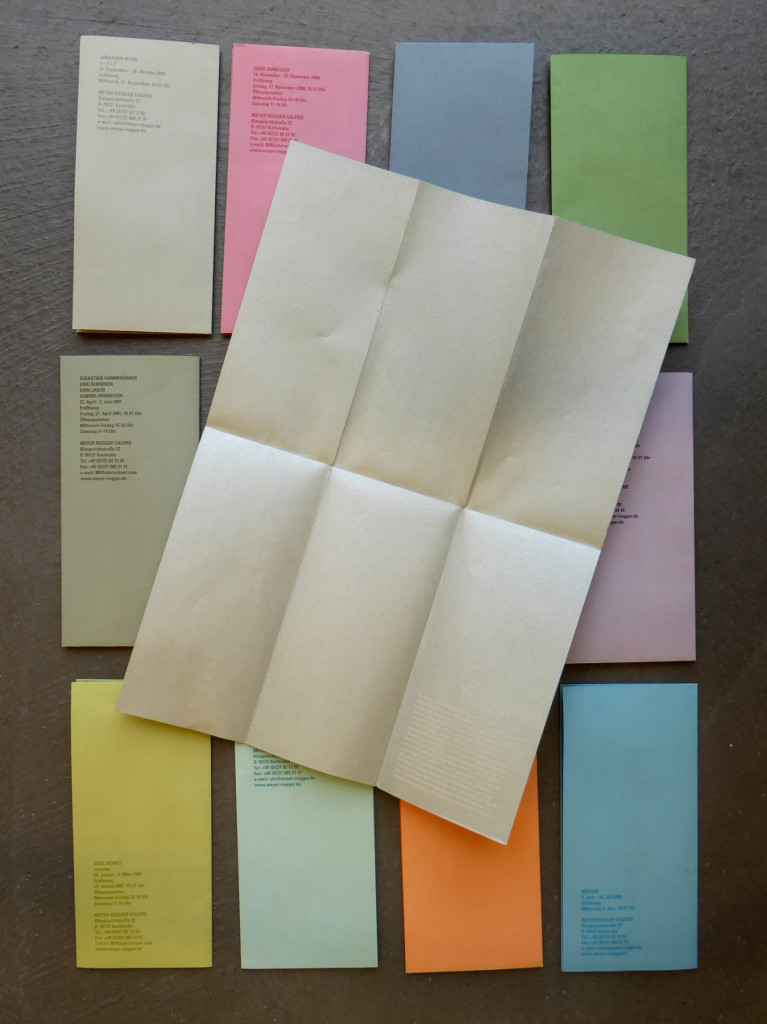
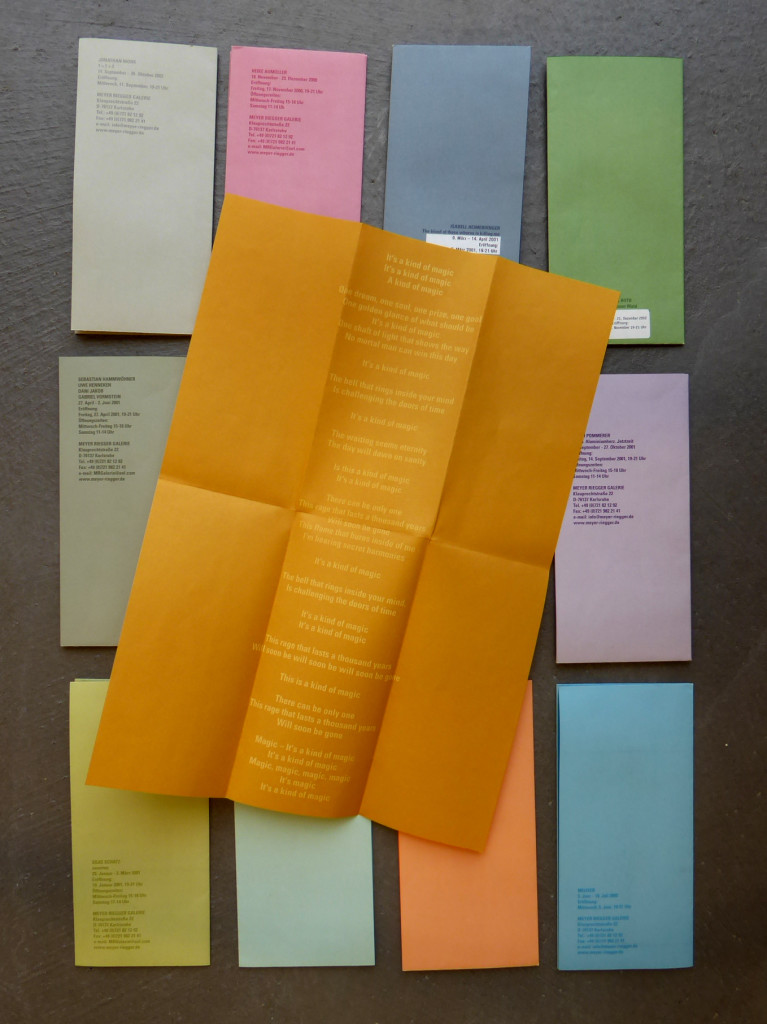
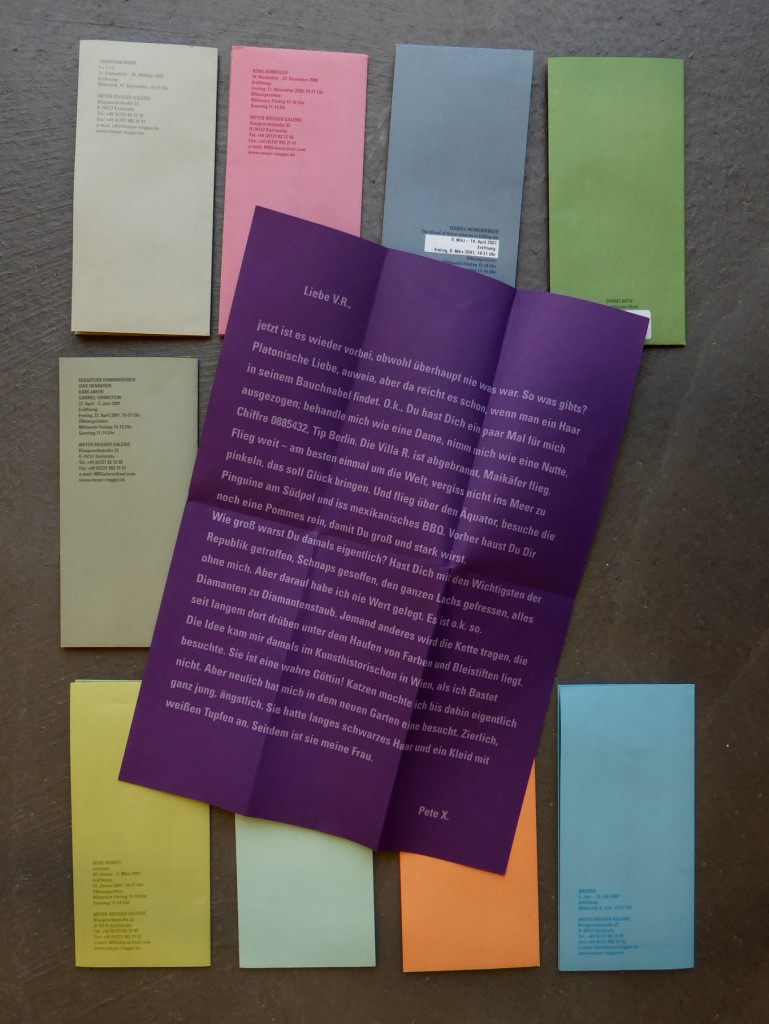
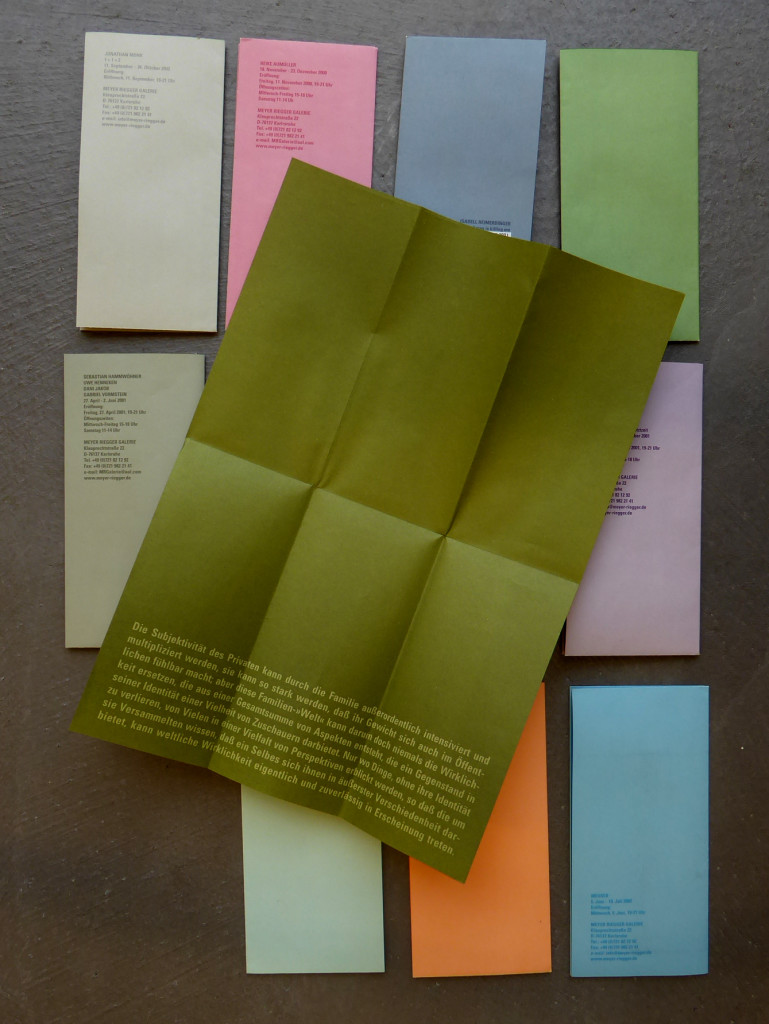
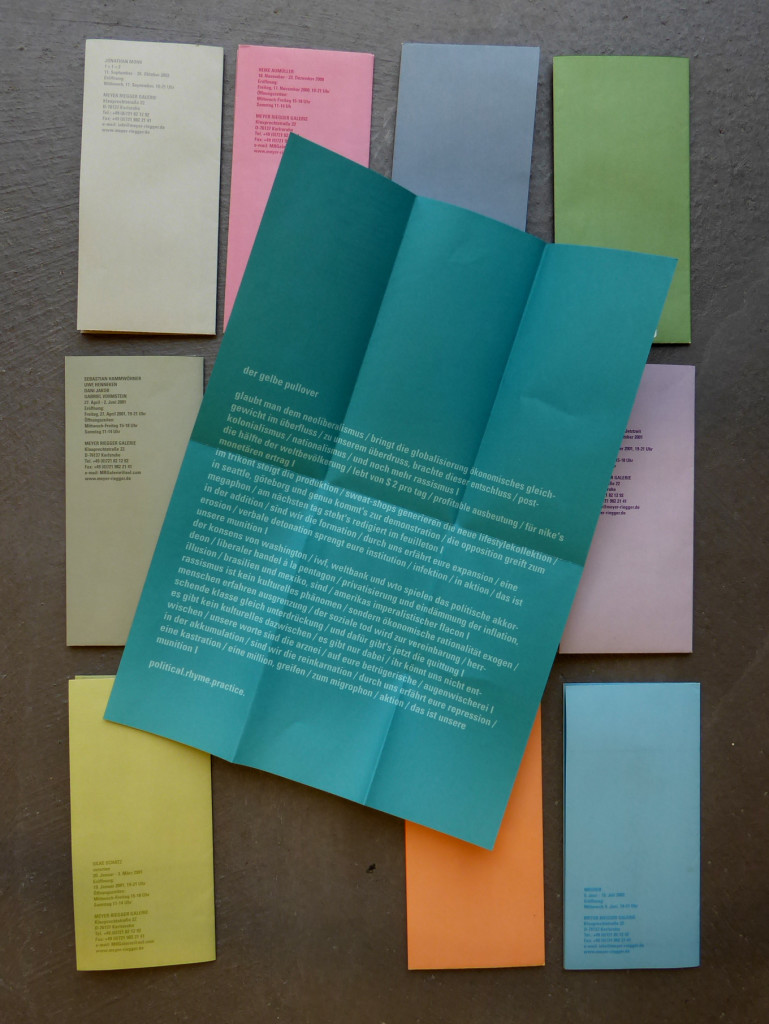
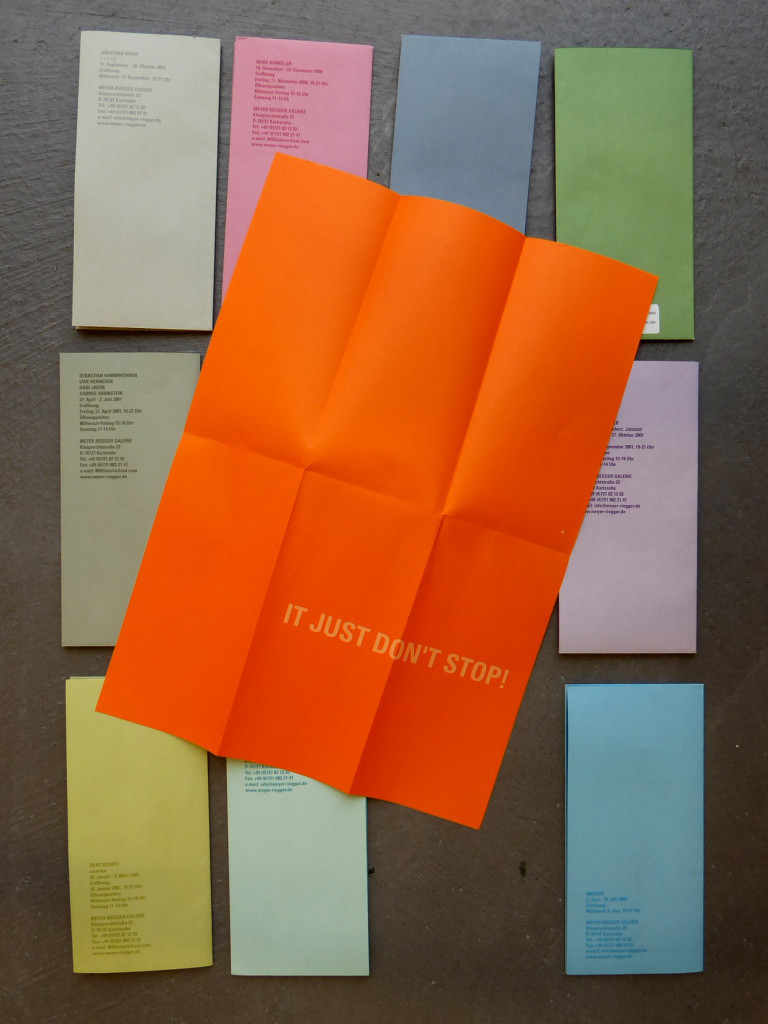
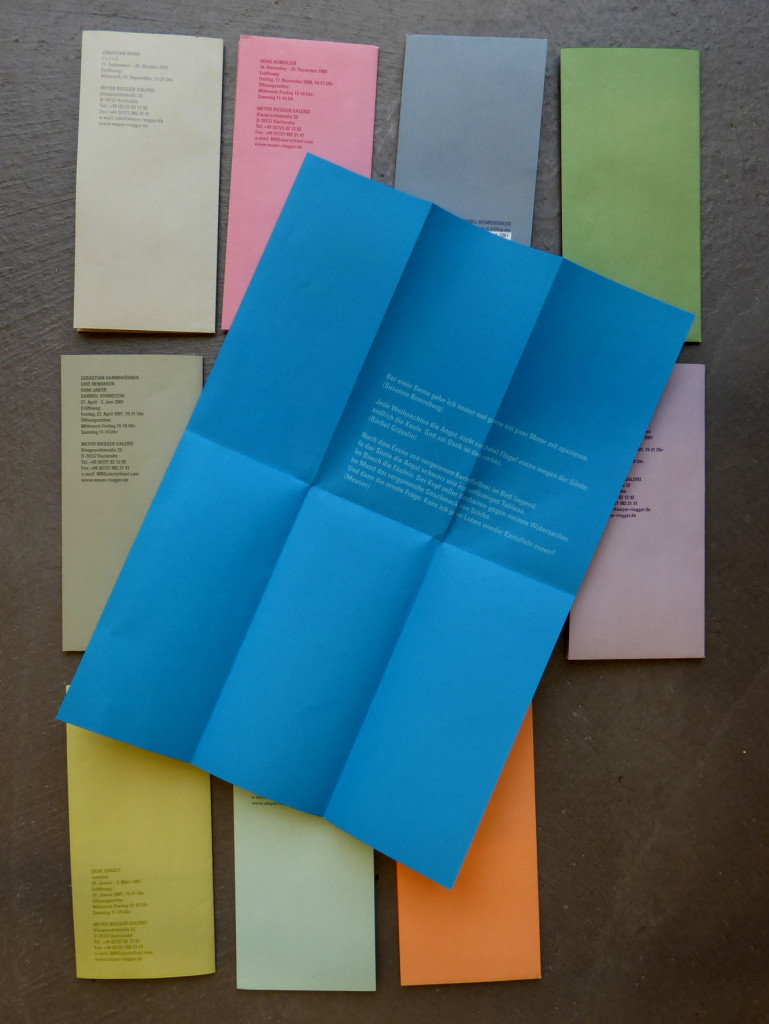
A series of folded invitations cards/posters by Meyer Riegger Galerie (est. 1997 in Karlsruhe, since 2008 also in Berlin). The exhibiting artist would choose the text for the inside, a quote, a poem, a short text. As many of the new young galleries established in the mid to late nineties, Meyer Riegger Galerie used their invitation cards to highlight individuality and as an innovative form of (self-)branding. Invitation cards could become an art project, and a space where art may happen – and is distributed worldwide for free. A similar strategy was adopted by other young up-and-coming galleries such as neugerriemschneider, Berlin (est. 1994), Gavin Brown’s Enterprise, New York (1994-2020), CFA Contemporary Fine Arts, Berlin (est. 1992), The Modern Institute, Glasgow (est. 1997), or Eva Presenhuber (Galerie Walcheturm 1989-1998/Galerie Eva Presenhuber).
Körner Union
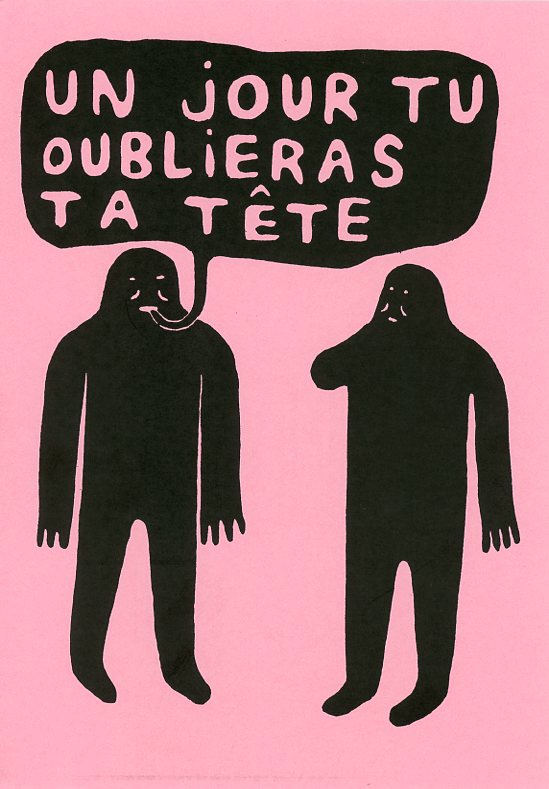
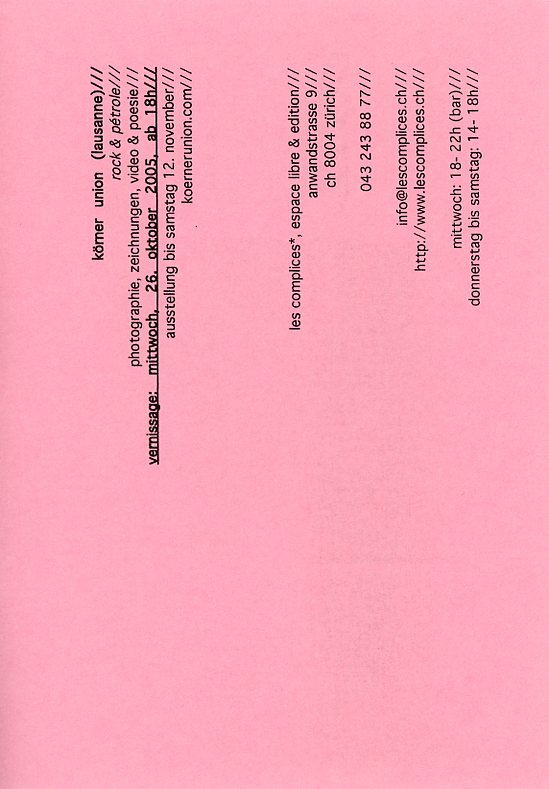
Since 1999, Sami Benhadj, Tarik Hayward and Guy Meldem have been working together under the name Körner Union. We produce commercials, music videos, prints and features. “Je connais les artistes et je me souviens d’une carte de voeux qu’ils avaient evoyée, avec cet humour décalé. Mais je n’ai pas vu l’exposition présenteée par ce flyer.” (user comment)
Cyprien Gaillard at frac champagne-ardenne
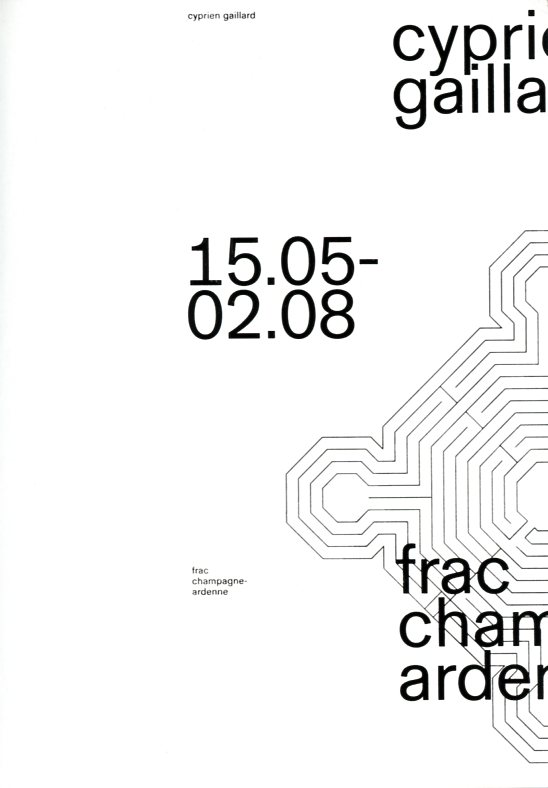
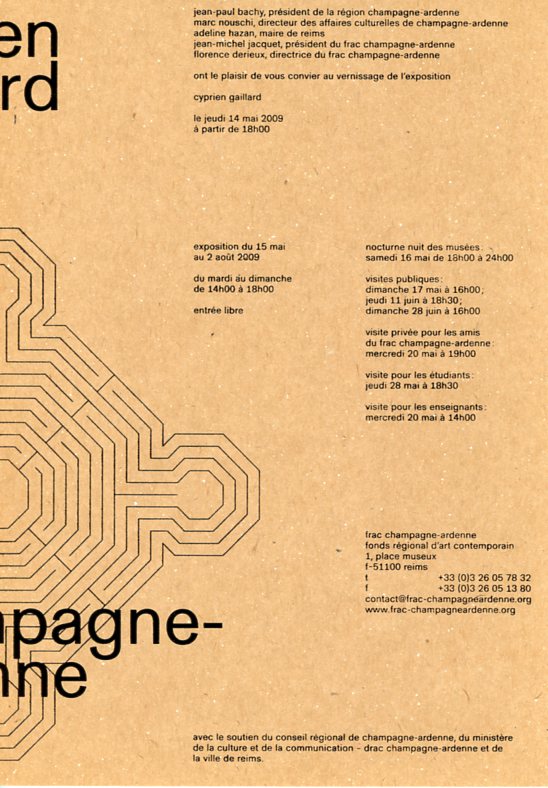
An invitation card for Cyprien Gaillard’s exhibition at frac champagne-ardenne. The frac still send invitation cards, as many French instiution continue to do. Sometimes in very ambitious forms. If I am not mistaken, the graphic concept is by Gavillet & Rust, in charge of the frac champagne-ardenne’s graphic identity since 2008. The studio was originally established in 2001 as Gavillet & Rust by Gilles Gavillet and David Rust (1969-2014).
künstlerbücherkünstler
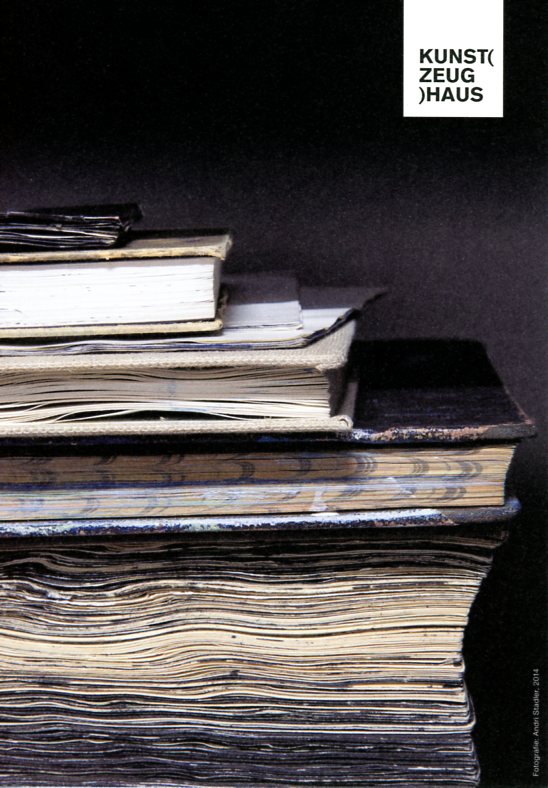
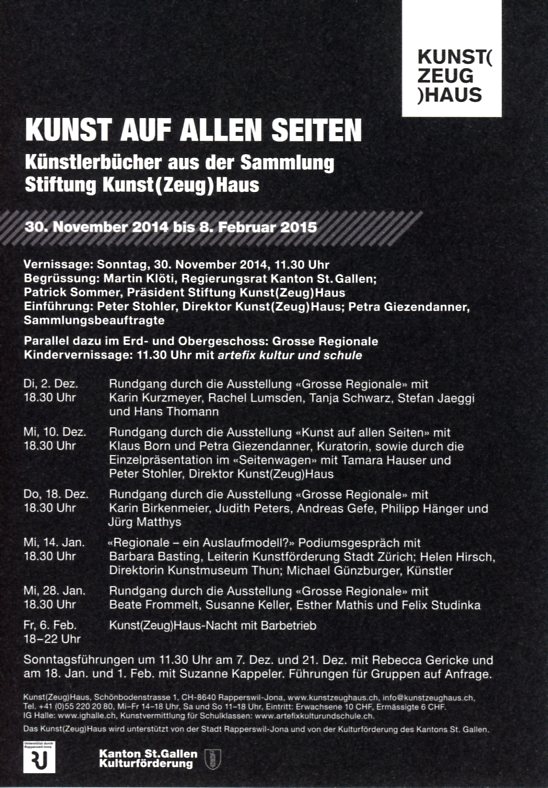
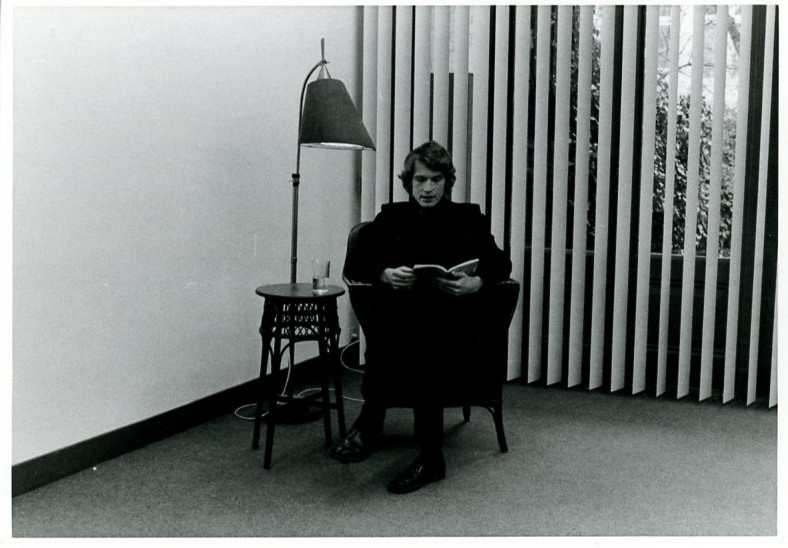
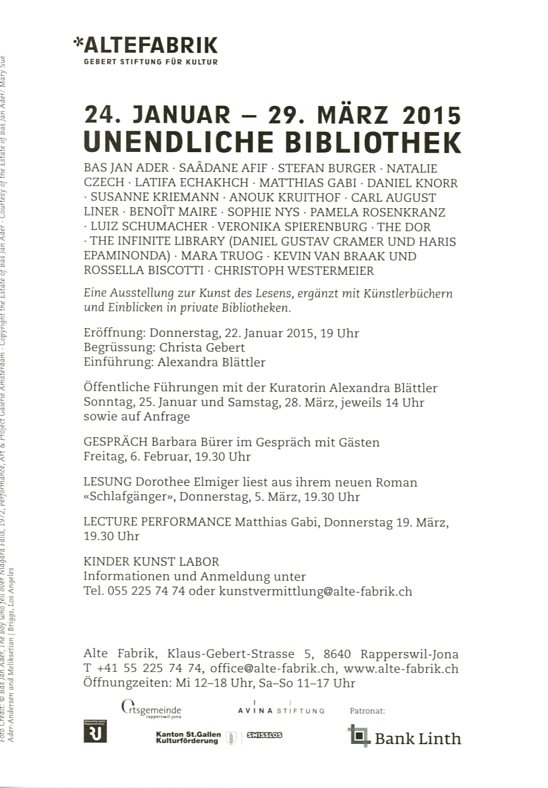
Aus Bibliotheken wird man klug. Zwei Ausstellungen, fast gleichzeitig, beide mit Büchern. Was ist eine Bibliothek anderes als eine katalogisierte Sammlung? Thomas Schlup
Mark Leckey
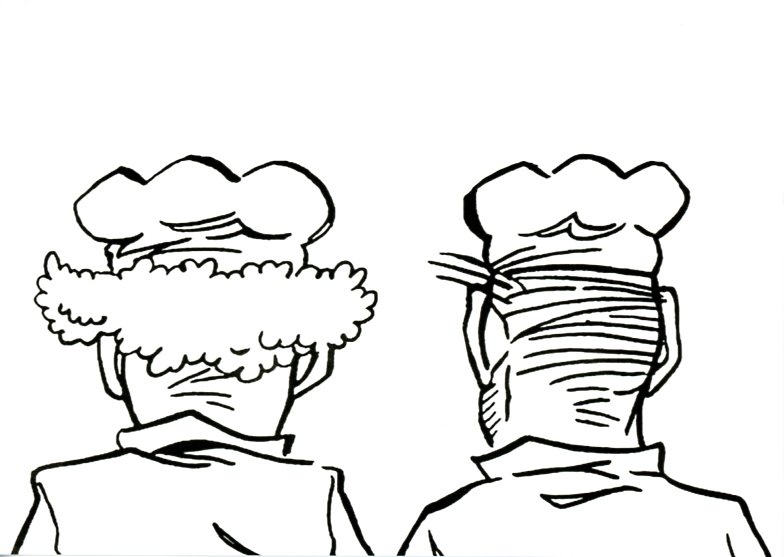
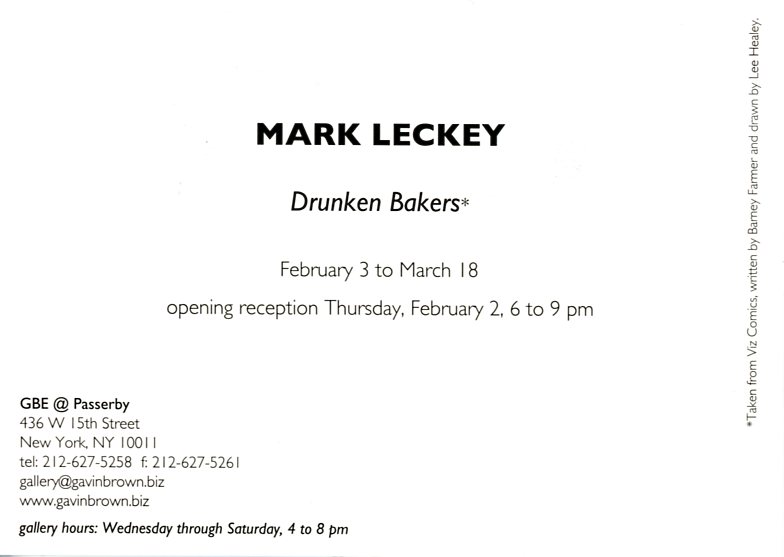
In 2006 The Drunken Bakers were the subject of a film by Mark Leckey (to be watched). Leckey created a film using frames from the original strips to construct a narrative and added a soundtrack spoken by himself and his colleague Steve Claydon in Liverpudlian accents. According to Emily Mears,
By fading the screen to black between episodes, Leckey constructs an elliptical narrative that mirrors the sense of time lost by the drinkers and the viewer. The video plays in a white box with a white carpet; a clock projected onto the outside of the box tells a stuck time, the hour hand slipping back to three each time it manages to reach four.
In Roberta Smith’s words, Leckey constructs “dreamy, druggy, disjointed variants on music videos…He has ingeniously filmed the comic strip with close-ups and jump-cuts, creating a kind of stop-action animation, and added a skillfully explicit soundtrack replete with convincing belches, slurps, breaking glass and vomiting.” Smith says that Leckey’s artwork is less an original work than an “adaptation or an homage” of the original cartoon. (as reported by Cabinet’s website)
Comment by a user Thomas Schlup: “‘Betrunkene Bäcker’ nannte sie Mark Leckey; mich erinnern sie aber an die beiden Jungs bei Busch, einfach ein wenig in die Jahre gekommen. Das waren vielleicht nur Doubles, die gemahlen wurden, und die Originale sitzen hier auf dem Bänklein vor dem Haus und erzählen dem Wilhelm ihre Missetaten aus der Jugend. Drei-Gupf-Hüte. Keck.”
Don Brown
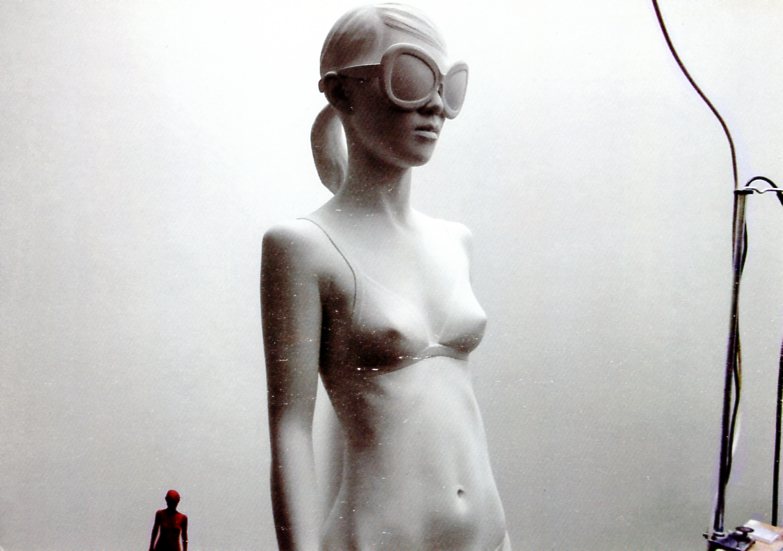
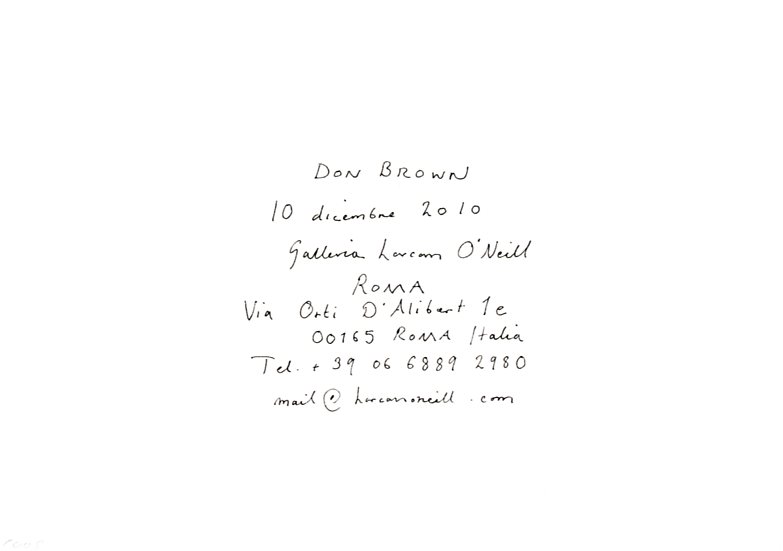
Don Brown is a sculptor best known for his dedication to varied depictions of his wife, Yoko. Since 1999, Brown has been producing three-quarter or half-scale portraits of Yoko using a classical tradition of representational sculpture, but without heroism or idealization. The figure, almost always with downcast or closed eyes, appears in various states of dress—sometimes obscured
Villa Magica and friends: Season’s Greetings
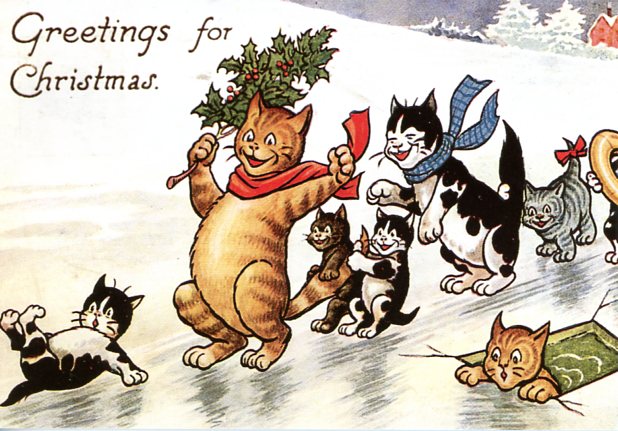
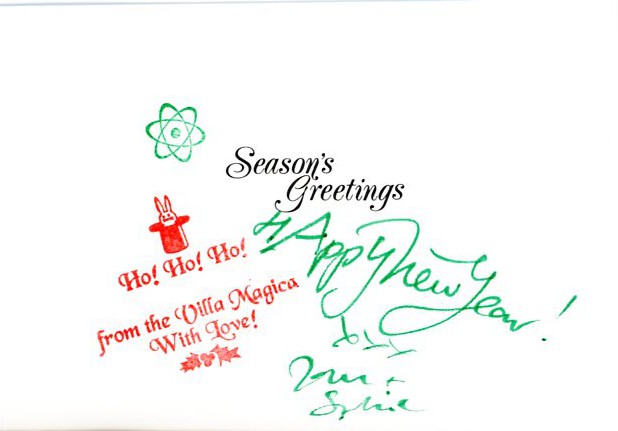
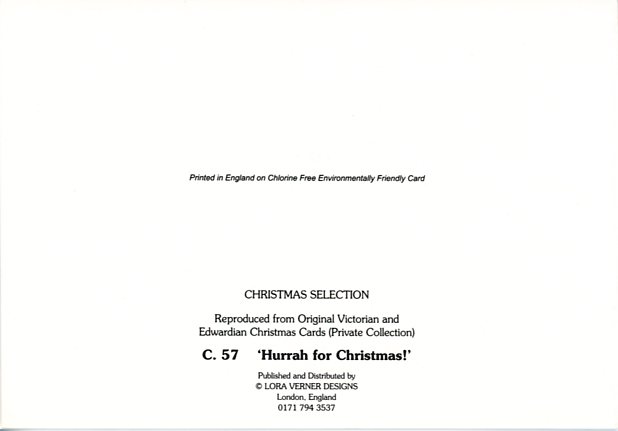
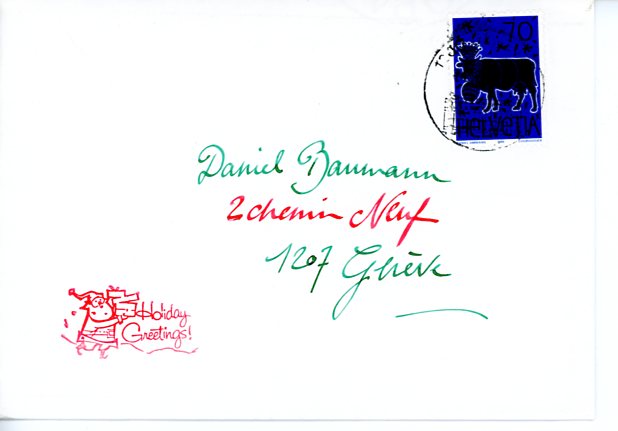
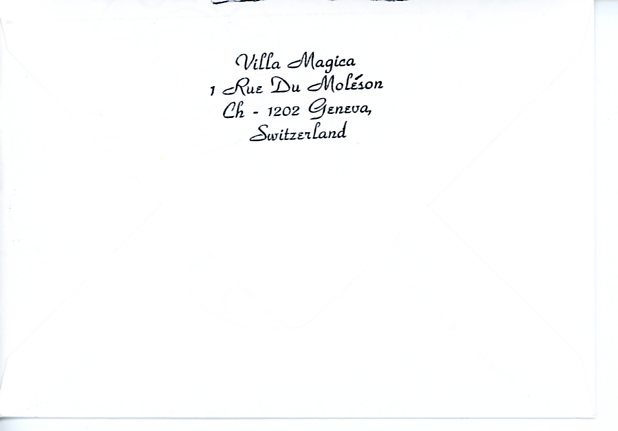
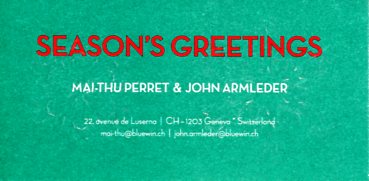
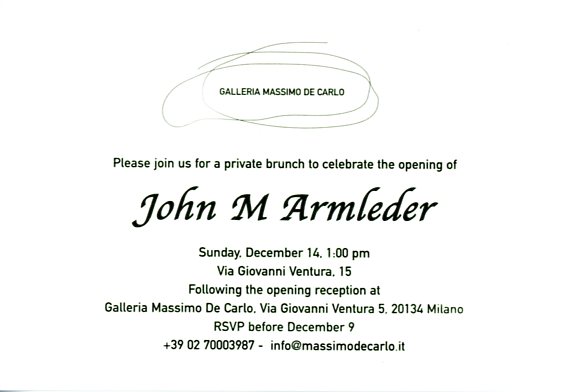
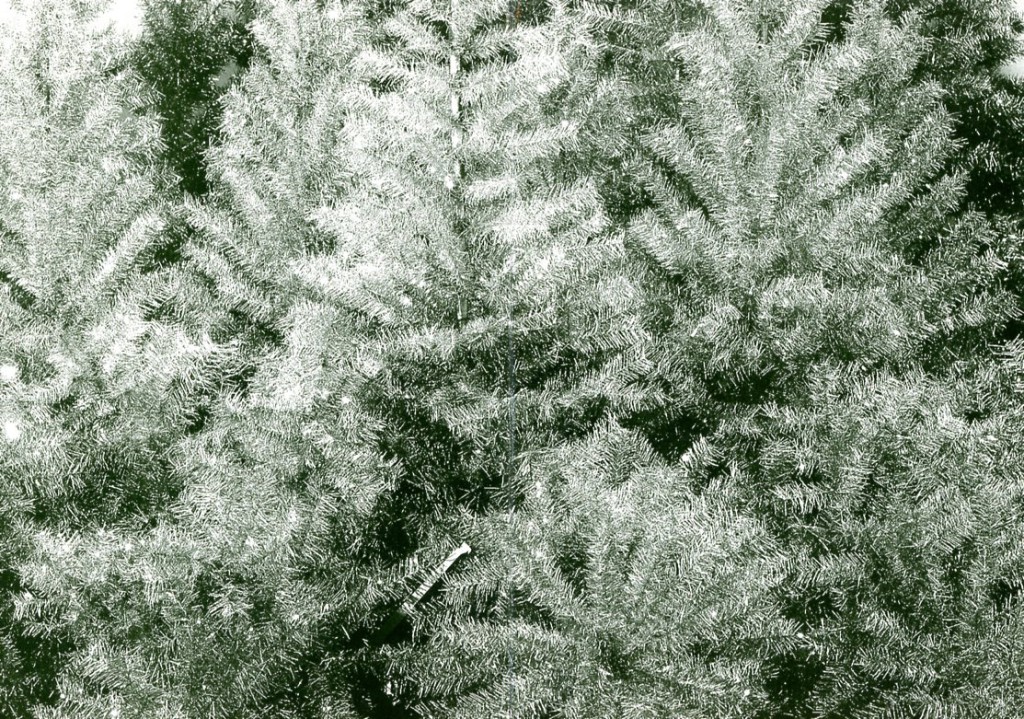
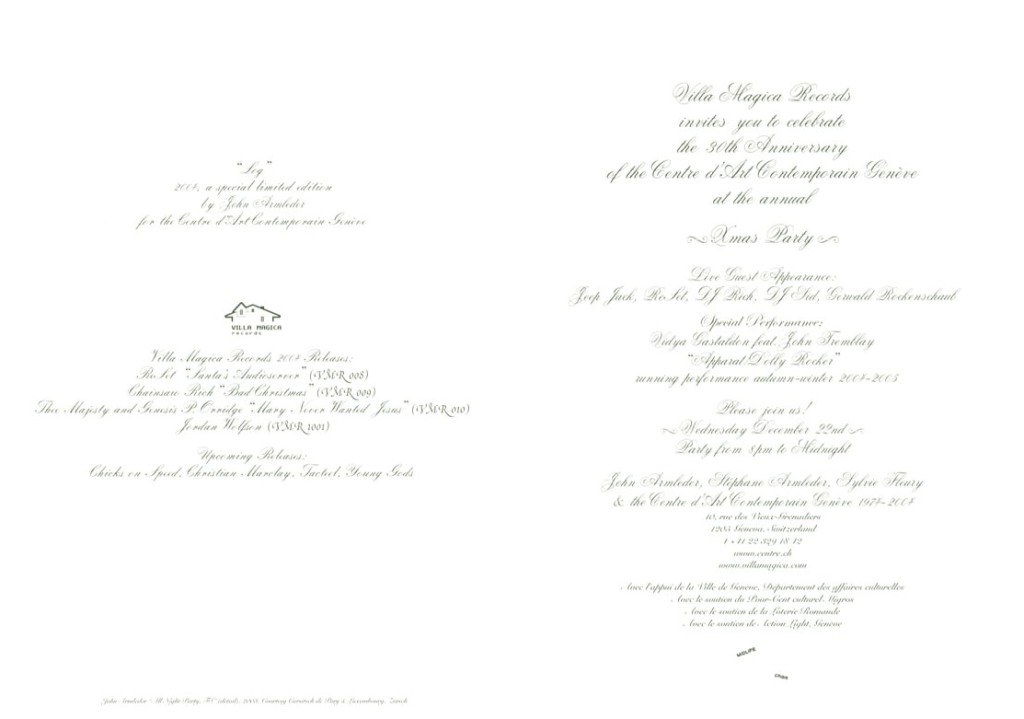
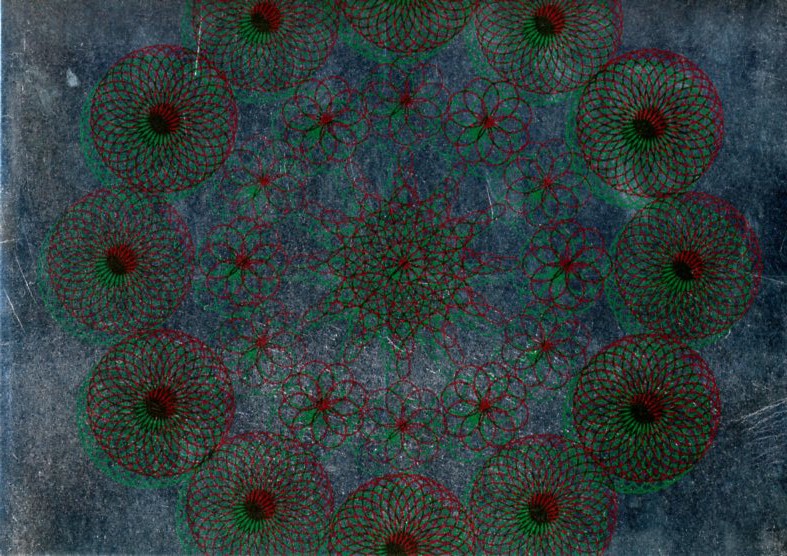
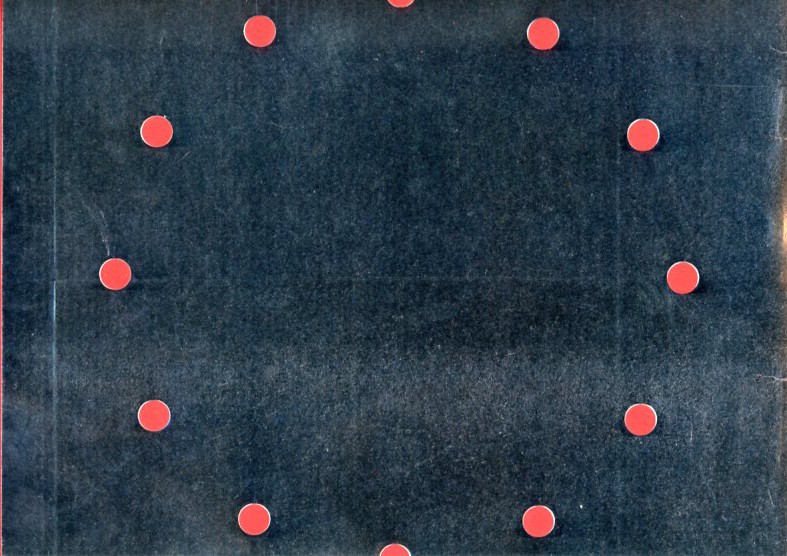
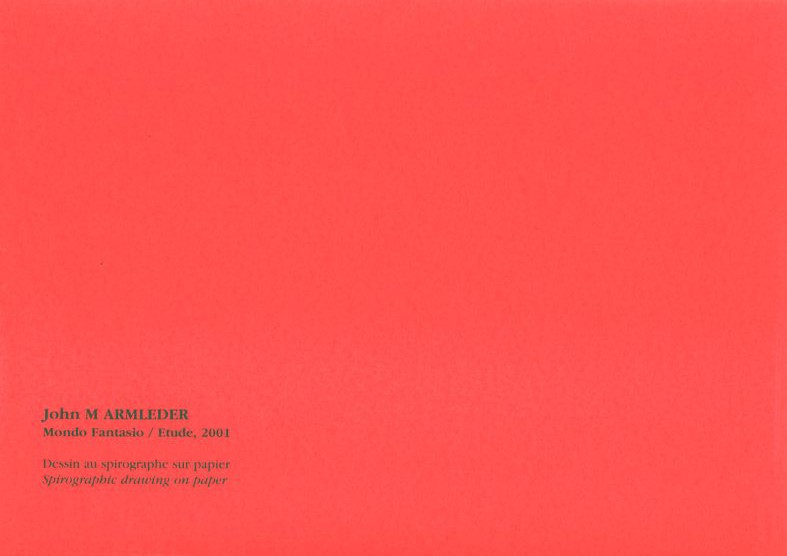
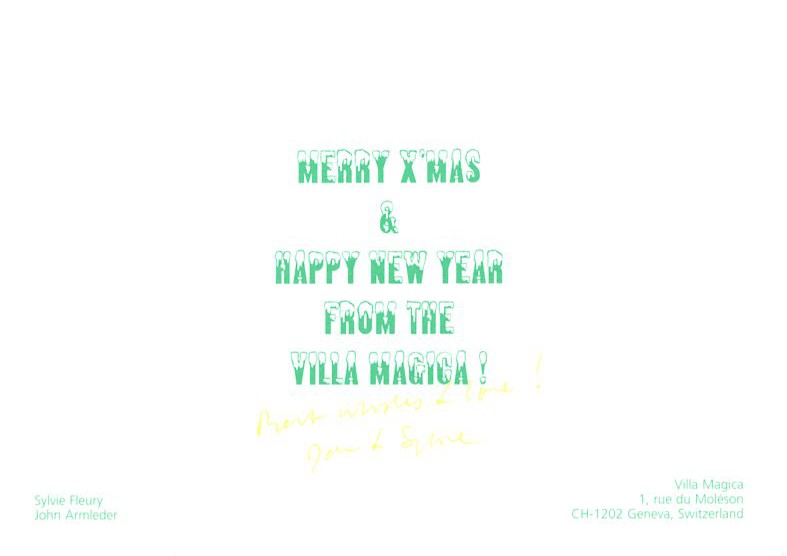
Annual Season’s Greetings by Villa Magica, the Geneva-based label founded by Sylvie Fleury, John Armleder, and Stephan Armleder (aka The Genevan Heathen). Here and here some of the label’s music, LPs, and CDs. They also have or had a tumblr page.
Comment by User Thomas Schlup: “Leicht antropomorphe Katzen mit einem Mistelzweig auf einer vergnügten Rutschpartie wie es sie nur in England geben kann. Die Karte ist ein Nachdruck aus einer privaten Sammlung, und nun ist sie wieder gesammelt worden. Eine ganze Sammlung an Schriften – gesetzt, gedruckt, gestempelt, geschrieben. Die kleine Grüne Karte hat zwei eingeprägte Schneesterne. Die Lamettabäume funkeln prächtig.”
Tim Rollins and K.O.S.
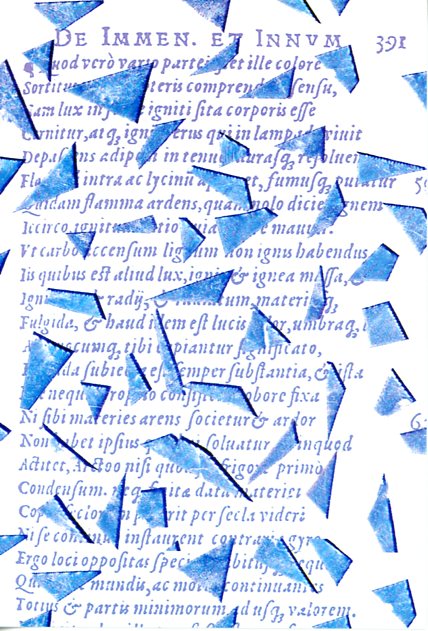
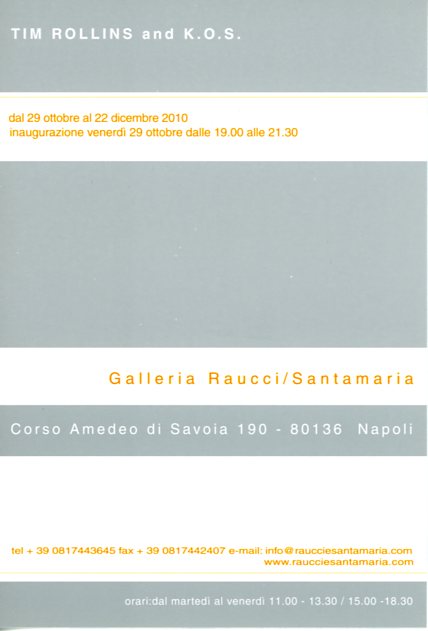
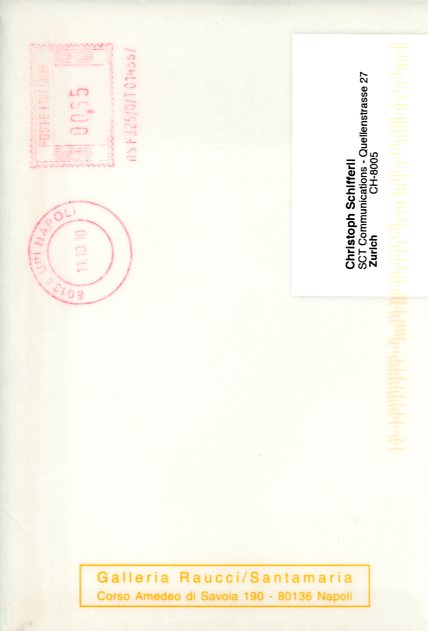
“What began in the 1980s as a program for South Bronx teenagers with learning disabilities grew quickly into a successful art collective called Tim Rollins and K.O.S. (Kids of Survival), whose works are in the collections of major museums. Now it’s composed of four middle-aged men: the brothers Angel Abreu and Jorge Abreu, Rick Savinon and Robert Branch.” Ted Loss in January 2021 in “The Kids of Survival Are Middle-Aged — and Transforming Yet Again” in The New York Times article.
This invitation card comes from the Neapolitan Galleria Raucci/Santamaria (est. 1992) for their show in 2010, here some images. Tim Rollins died in 2017.
Comment by user Thomas Schlup: “Tim Rollins und seine Kids of Survival nehmen alte Drucke und befördern sie in die Gegenwart. Aus der South Bronx an den Fuss des Vesuv. Die Schrift: möglicherweise ‘Aldus’. Die erste Kursive Druckschrift. Aus der Zeit, als die ‘Bembo’ geschnitten wurde, heute noch eine der lesbarsten Schriften überhaupt. Aldus (Manutius) war der Namensgeber für die Firma mit dem ‘PageMaker’, als das Arbeiten am Computer noch Desktop Publishing hiess. Essentiell: das hauchzart durchscheinende Couvert.”
Jochen Lempert
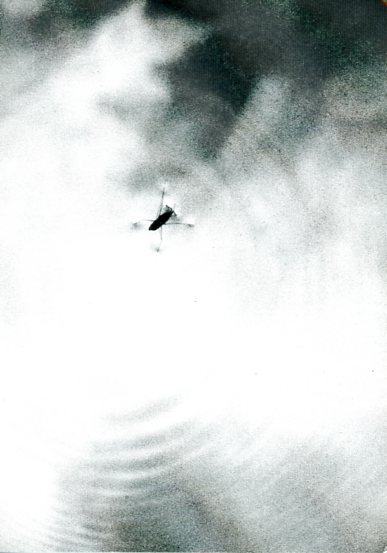
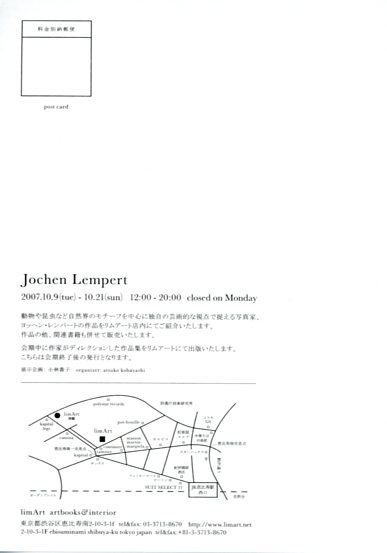
Jochen Lempert ist mir vor zwei Jahren in Paris begegnet. Ich mag seinen Blick auf die scheinbaren Nebenschauplätze. Diese Fotografie ist irritierend und zauberhaft: Das kleine Gewicht auf der Wasseroberfläche; die Spannung, die es trägt. Faszinierend: der weite Raum, der sich im Wasser spiegelt. Das unscheinbar Kleine im unendlich grossen Raum.
Announcement for Armand Schulthess: Rekonstruktion eines Universums
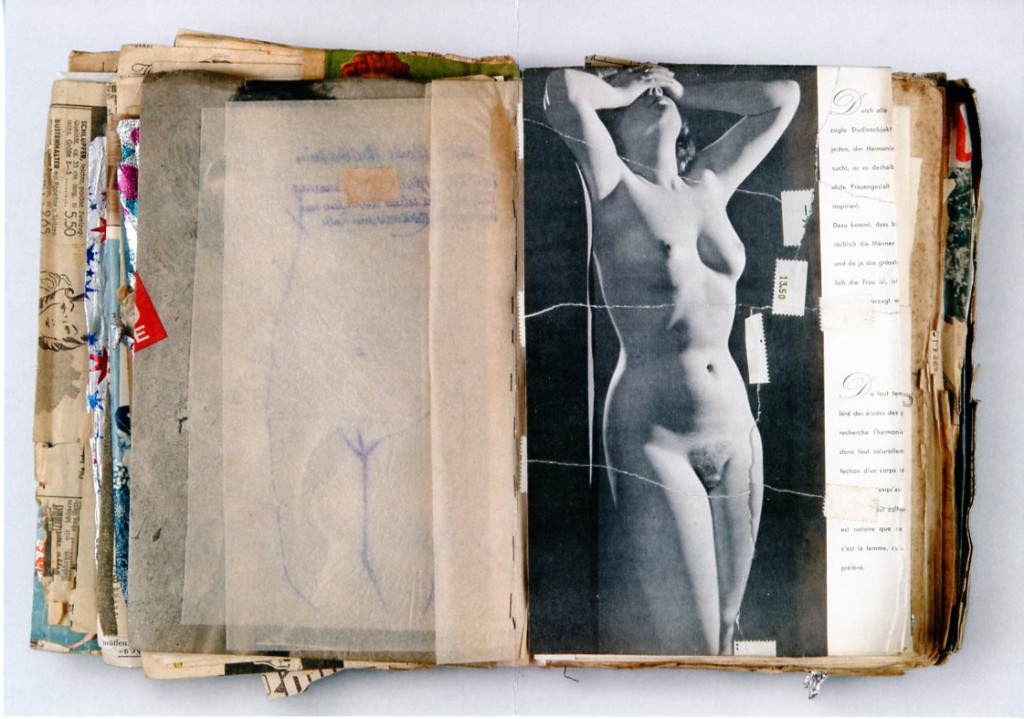
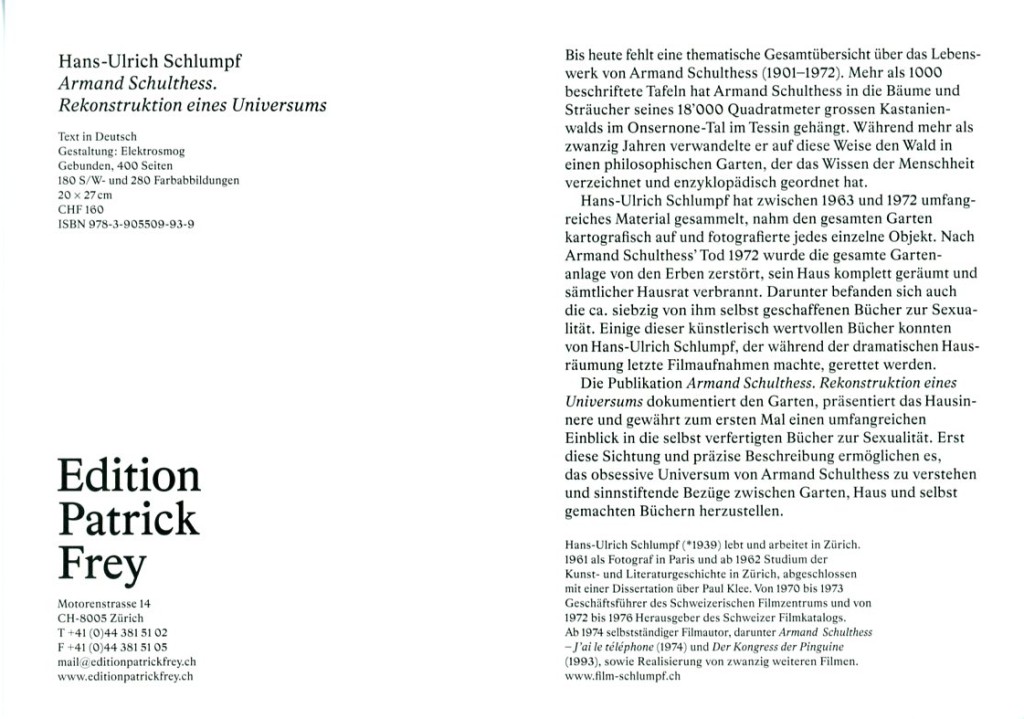
Announcement for a publication by Hans-Ulrich Schlumpf on Armand Schulthess who hung more than 1,000 inscribed panels in the trees and bushes of the 18,000 square meters of his chestnut woods in the Onsernone Valley in Ticino. Over a period of more than twenty years he transformed the woods into a philosophical garden that chronicled human knowledge and arranged it encyclopedically. Edition Patrick Frey
Comment by user Thomas Schlup: “Das Universum des Armand Schulthess im Onsernonetal. Ingeborg Lüscher hat uns etwas davon gerettet, Hans-Ulrich Schlumpf auch. Ein Buch ist daraus geworden. Der grosse Rest: Von verständnislosen Erben innert drei Tagen dem Erdboden gleichgemacht. In der Schweiz hat es keinen Platz für ‘Sonderlinge’. Was für ein garstiges Land.”
 follow
follow